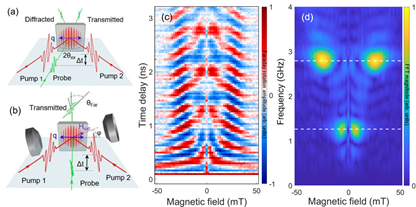Hybrid quasi-particles in condensed matter systems are observed at the degeneracy points between different degrees of freedom exhibiting non-zero coupling. These solid-state chimeras could be exploited in a wealth of applications, ranging from transducers to sensors, to memory and logic units [1]. In particular, when the dispersion relation of phonons and of magnons are degenerate, magnetostriction can allow for efficient cross-talk between lattice and spin reservoirs in the few gigahertz range. Notably, such degeneracy can take place at finite wavevector: suitable experimental methods to investigate the dispersion relation in the vicinity of the mode crossing are called for.
|
|
|
Fig.1 (a-b) Sketch of the setup for TG and for TG-pumped optical polarimetry. (c-d) Time domain and FFTmaps of the Faraday rotation signal providing evidence of TG-pumped magneto-acoustic dynamics. |
I will present recent experimental results on finite-wavevector magneto-acoustics in ferromagnetic thin film and nanostructures [2]. The systems have been investigated via optical Transient-Grating (TG) spectroscopy and time-resolved MOKE at NFFA-SPRINT laboratory (Trieste) [3]; correlative characterization of the samples via ferromagnetic resonance, Brillouin scattering and micromagnetic simulations further confirm the observed dynamics and allow to draw the boundary for reliable data interpretation. Hamiltonian modelling of the mode crossing allows to quantify the magnon-phonon coupling strength and the degree of coherence in the coupling.
Impulsive photon-driven excitation of finite-wavevector excitations can be fruitfully extended down to the mesoscopic scale, e.g. by FEL-based TG spectroscopy, a technique that is getting growing attention from the scientific community [4-5]. I will present experiments conducted in collaboration at FERMI FEL (Trieste) and Eu-XFEL (Hamburg) which aim at establishing X-ray TG spectroscopy as a routine tool for condensed matter physics.
[1] M. Harder et al., J. Appl. Phys. 2021, 129, 201101.
[2] P. Carrara et al., Phys. Rev. Appl. 2022, 18, 044009.
[3] M. Brioschi et al., Opt. Lett. 2023, 48, 167-170.
[4] C. Svetina et al., Opt. Lett., 2019, 44, 574-577.
[5] D. Ksenzov et al., Nano Lett. 2021, 21, 2905−2911












